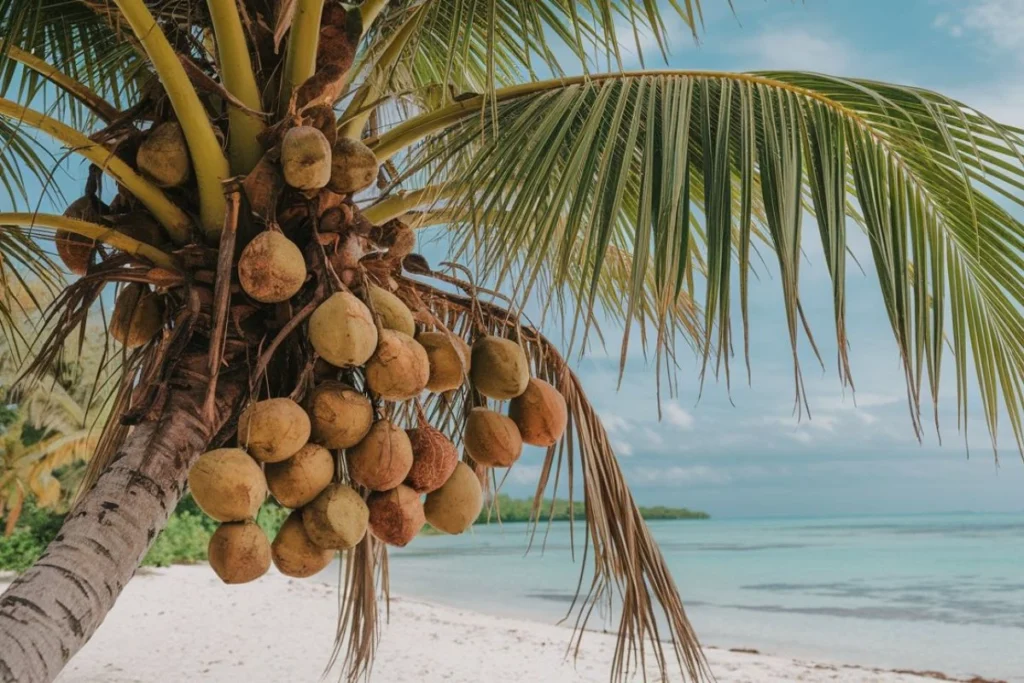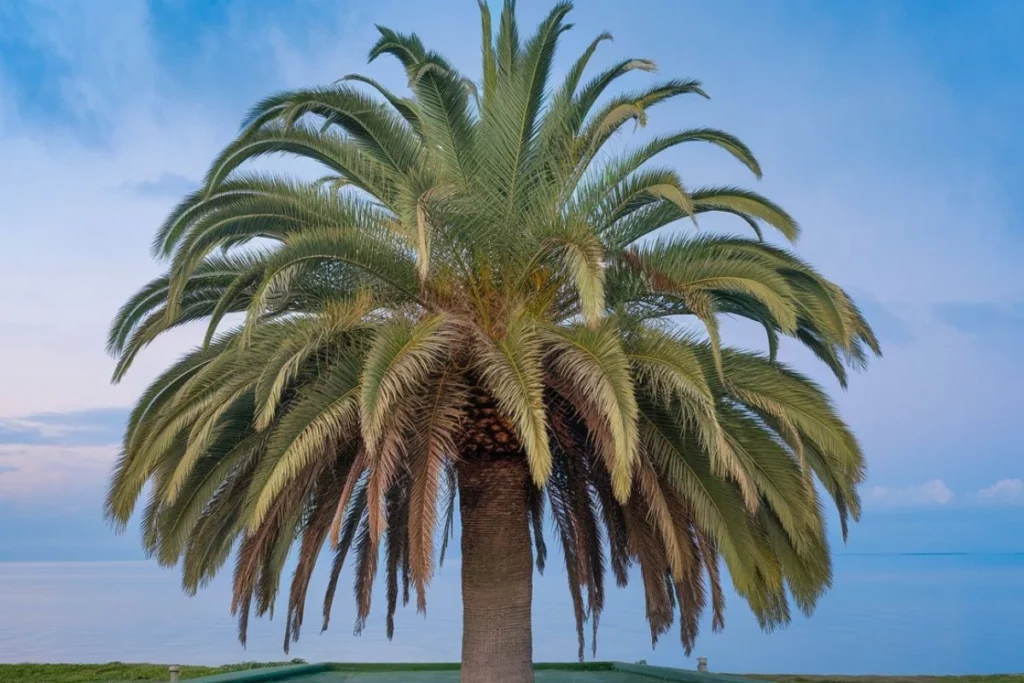Types of Palm Trees are an enduring symbol of tropical serenity, gracing beaches, gardens, and even indoor spaces with their iconic beauty. However, these versatile plants are far more than decorative. Palm trees play critical roles in ecosystems, cultural practices, and economies around the globe. With over 2,600 known species, their diversity is astounding. From towering giants that define coastal skylines to compact varieties that thrive in living rooms, palms come in various shapes, sizes, and functions.
This article delves into five prominent types of palm trees, exploring their unique traits, habitats, ecological importance, and practical uses. Whether you’re considering adding palms to your landscape or simply curious about these remarkable plants, this guide has you covered.
1. Coconut Palm (Cocos nucifera)

Overview
The coconut palm is perhaps the most famous Types of Palm Trees, recognized for its tall, slender trunk and abundant production of coconuts. Its feathery fronds form a lush canopy that sways gracefully in the breeze. Found in tropical and subtropical regions, coconut palms are a symbol of paradise.
Physical Characteristics
- Height: Can grow as tall as 95 feet.
- Leaves: Long, feather-like fronds, each measuring 15–17 feet.
- Fruit: Coconuts, with a hard outer shell, fibrous husk, and nutrient-rich interior.
Habitat and Growth
Native to Southeast Asia, coconut palms thrive in sandy, well-draining soils with high salinity tolerance. They are common along coastlines, requiring full sun and warm temperatures. The tree’s extensive root system helps it anchor in unstable soil, even in areas prone to erosion or strong winds.
Uses
- Culinary: Coconut water, meat, and milk are staples in cuisines worldwide. Dried coconut, or copra, is used to produce coconut oil.
- Craft and Industry: The husks are processed into coir, used for mats, ropes, and brushes. The wood and leaves are used for construction and crafting handmade items.
- Cultural Significance: Coconuts hold ceremonial and religious importance in many tropical cultures, often symbolizing fertility and prosperity.
Ecological Contributions
Coconut palms stabilize shorelines, reducing erosion and serving as windbreaks. The fruit is an essential food source for animals like crabs and bats, while the tree provides habitat for various bird species.
2. Date Palm

Overview
Renowned for its sweet and nutritious fruit, the date palm is one of humanity’s oldest cultivated trees. Its graceful appearance and productivity make it a staple in desert and semi-arid regions.
Physical Characteristics
- Height: Reaches a height of up to 74 feet.
- Leaves: Long, pinnate leaves up to 16 feet in length.
- Fruit: Dates, clustered in bunches, range in color from golden yellow to deep brown when ripe.
Habitat and Growth
This Types of Palm Trees Originating in the Middle East, date palms are perfectly adapted to hot, dry climates. They require well-drained sandy or loamy soil and thrive in regions with minimal rainfall, provided they receive irrigation.
Uses
- Food: Dates are a staple food in many countries, eaten fresh or dried. They are also processed into syrups, pastes, and confections.
- Construction: The tree’s sturdy wood and fronds are used for building materials, roofing, and weaving.
- Cultural Importance: Mentioned in historical texts and religious scriptures, date palms symbolize sustenance and resilience.
Ecological Contributions
In arid ecosystems, date palms provide vital shade, cooling microclimates for other crops and animals. Their fruits feed birds, rodents, and humans alike, while their roots improve soil quality by retaining moisture.
3. Areca Palm
Overview
Commonly referred to as the butterfly palm or golden cane palm, this Types of Palm Trees is a popular choice for both indoor and outdoor landscaping. Its lush fronds and golden-yellow stems create a tropical ambiance, making it a preferred choice for gardeners and designers.
Physical Characteristics
- Height: Typically grows between 6 to 30 feet, depending on the environment.
- Leaves: Gracefully arching fronds composed of 40–60 individual leaflets.
- Trunk: Multiple slender, yellow-green trunks form clumps.
Habitat and Growth
Types of Palm Trees Native to Madagascar, Areca palms thrive in warm, humid climates. They prefer well-drained soil and partial sunlight, although they can adapt to shaded environments indoors.Consistent watering and occasional pruning are essential to keep them healthy.
Uses
- Landscaping: Popular in gardens and patios for their vibrant foliage.
- Indoor Decor: Valued as an air-purifying plant that enhances indoor air quality by removing toxins like formaldehyde and carbon dioxide.
- Privacy Screens: When planted in rows, they form natural barriers or hedges.
Ecological Contributions
In their natural habitat, this Types of Palm Trees provide shelter for birds and insects. While their ornamental use dominates, they contribute to biodiversity in gardens by attracting pollinators.
4. Royal Palm Types of Palm Trees

Overview
With its regal stature and smooth, columnar trunk, the Royal Palm is a striking addition to landscapes. This species is often associated with luxury and grandeur, frequently used in public spaces and private estates.
Physical Characteristics
- Height: Can grow as tall as 96 feet.
- Leaves: Arching, glossy green fronds up to 15 feet long.
- Trunk: Smooth and gray, slightly swollen at the base.
Habitat and Growth
Native to the Caribbean, Royal Palms are well-suited to tropical and subtropical regions. They require fertile, well-drained soil and benefit from consistent watering. These palms are drought-tolerant once established, this Types of Palm Trees making them a low-maintenance choice for large landscapes.
Uses
- Ornamental: Royal Palms are often planted as statement pieces along streets, driveways, or in parks.
- Symbolic: In some cultures, they represent prosperity and victory.
- Biodiversity Support: Their flowers attract bees, while their fruits sustain birds and bats.
Ecological Contributions
Royal palms enhance urban greenery, providing shade and habitat in cityscapes. Their presence helps offset the urban heat island effect, cooling surrounding areas and improving air quality.
5. Sago Palm (Cycas revoluta)
Overview
without name, the Sago Palm is not a really palm but a cycad, an ancient group of plants. Its symmetrical growth pattern and compact size make it a versatile choice for gardens and interior decoration.
Physical Characteristics
- Height: Typically grows between 3 to 10 feet, with occasional specimens reaching up to 20 feet.
- Leaves: Stiff, dark green, and feather-like.
- Trunk: Thick and textured, resembling a miniature palm trunk.
Habitat and Growth
Native to southern Japan, Sago Palms are hardy plants that tolerate a wide range of conditions. They prefer well-drained soil and thrive in both full sun and partial shade. However, they grow slowly, taking years to mature fully.
Uses
- Ornamental: Ideal for small gardens, courtyards, and indoor spaces due to their manageable size and striking appearance.
- Educational Value: With origins tracing back millions of years, they are often showcased in botanical gardens as living fossils.
- Practical Use: Starch extracted from the pith is processed into sago, though it requires careful preparation due to its natural toxicity.
Ecological Contributions
In their native habitats, Sago Palms contribute to biodiversity by serving as host plants for specific insect species. Their seeds, are food for certain wildlife.
Key Considerations for Palm Selection
When choosing a Types of Palm Trees for your space, it’s essential to evaluate the following:
- Climate Suitability: Match the palm’s requirements to your local weather conditions. For example, coconut and date palms thrive in hot climates, while Areca and Sago palms adapt to a broader range.
- Soil Type: Most palms prefer well-draining soil, though species like the coconut palm tolerate sandy, saline environments.
- Purpose: Decide whether the palm will serve as a decorative feature, a privacy screen, or a functional crop.
Conclusion
Types of Palm Trees are much more than picturesque backdrops for tropical vacations. They are vital components of ecosystems, cultural traditions, and economic industries worldwide. From the versatile coconut palm to the stately Royal Palm, each type offers unique benefits and beauty.
By understanding the characteristics, habitats, and uses of these five iconic palm trees, you can appreciate their contributions to both natural and human-made environments. Whether you’re looking to transform your garden, support biodiversity, or harvest their fruits palms provide endless possibilities and enduring charm.
Their adaptability and majestic forms ensure they remain a symbol of resilience and beauty, inspiring awe and admiration across generations.

